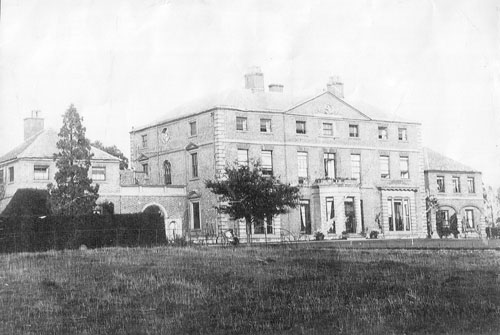Measham Hall
Derbyshire
| Location | Measham | ||
| Year demolished | 1959 | ||
| Reason | Unsafe due to mining subsidence | ||
| See all images: | Gallery | ||
| << Back to the main list |
Text written by, and copyright of, Nicholas Kingsley - many thanks
 Some houses are exceptionally obscure. One such is Measham Hall (Leicestershire, but originally Derbyshire). It was built in 1767 for William Abney (1713-1800), a London barrister who was the younger son of minor gentry family from nearby Newton Burgoland Hall. Although he only bought the estate after 1760, by the end of his long life he had become an almost legendary figure in the locality, both for the old fashioned open-handed hospitality he offered to his tenants, neighbours and visitors; and for his personal recollection of historical events and personalities (he had led a troop of local gentlemen to oppose the southward march of Bonnie Prince Charlie at Derby in 1745, for example).
Some houses are exceptionally obscure. One such is Measham Hall (Leicestershire, but originally Derbyshire). It was built in 1767 for William Abney (1713-1800), a London barrister who was the younger son of minor gentry family from nearby Newton Burgoland Hall. Although he only bought the estate after 1760, by the end of his long life he had become an almost legendary figure in the locality, both for the old fashioned open-handed hospitality he offered to his tenants, neighbours and visitors; and for his personal recollection of historical events and personalities (he had led a troop of local gentlemen to oppose the southward march of Bonnie Prince Charlie at Derby in 1745, for example).
Measham Hall is a seven bay, two and a half storey house with a three-bay pediment containing a little decoration, a hipped roof and quoins. At either side were one bay connecting links and three-bay two-storey angle pavilions with pyramid roofs. The style suggests the architect may have been William Henderson of Loughborough, although there is no documentary evidence. The interior is said to have had a grand staircase, rising the full height of the house, with three turned balusters per tread.
William Abney left a long and complex will. Measham Hall passed first to his eldest son, Robert Abney (1748-c.1808?), who was already established at Lindley Hall (Warks), which he had inherited from his wife's family. By the time Robert died, however, he had no surviving sons, and Measham therefore passed to his brother Edward Abney (1751-1827), who was painted by Joseph Wright of Derby, and whose second wife, Hephzibah Need, was an accomplished watercolourist. When he died in 1827, Measham Hall passed to his grandson, William Wotton Abney (1807-66), who died without surviving issue. He therefore left the hall to his widow, Helen John Sinclair Abney (c.1810-93) for life. On her death, the estate passed to W.W. Abney's eldest nephew, Sir William de Wivelslie Abney (1843-1920), a pioneer of photographic chemistry, who was knighted in 1900 for his contributions to science. (Sir William's father was an early amateur photographer and one of the founders of the Derby Photographic Society; his own work led ultimately to the development of colour photography, and of 'instant photography' such as the Polaroid process).
In the later 19th century - probably after Sir William Abney inherited in 1893 - the ground floor fenestration of the house was altered, with the insertion of large tripartite windows and a canted bay window. When Sir William died, the estate passed to his son, Lancelot Edward Guy Abney (1868-1939), who sold it to the Measham Colliery Co., who had extensive coal mines in the district, in 1924. They divided the house into flats after 1945, but it later became unsafe because of mining subsidence and was demolished in 1959.